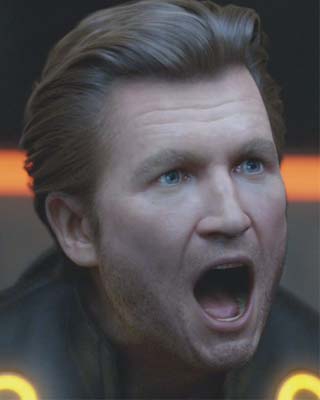by Joel G. Robertson
“Sometimes that [Dude] he looks right into ya. Right into your eyes. And, you know, the thing about [The Dude]… he’s got lifeless eyes. Black eyes. Like a doll’s eyes.” — paraphrasing Quint (Robert Shaw) in Jaws.
Cinematic Luddites
The knee-jerk reaction of many retro-movie lovin’ geeks to CGI is… blech! I’m guilty of it and you may be too. This is especially true when it applies to remakes or sequels to films from the 70s and 80s, the golden age of practical (i.e. “real”) special effects.
From Dick Smith’s work on The Exorcist (1973) through the golden age of Star Wars, on through the 80s with masters like Baker, Bottin, Winston, Savini, KNB, Johnson, “Screaming” Mad George, the Chiodo Bros., John Carl Buechler, and Dennis Muren (of course, he also helped usher in the age of CG effects), those pre-digital days gave many of us a bias toward all things latex and rubbery.
Think about it. When you heard “they” were making a new Indiana Jones movie were your first thoughts: “Awesome! Sure, Ford’s getting a little long in the tooth, but damn, I’m sure Lucas and company will get this one right! I mean, look at how freakin’ sweet the Star Wars prequels were, especially Attack of the Clones. Man, I get all bunched up just thinking about that INSANELY LONG SEQUENCE between Padme and Anakin!”? Or, like me, was your thinking more along the lines of: “WHAT THE #@&!? Man, they’re gonna totally #@&!? this up! Hell, they’ll probably even give Indy a CGI-bull whip!”?
Of course, Spielberg and company assured as that Indy came from an “analog” world, so while there might be some CGI, the majority of the effects would be practical… riiiiiiiiiiiiiiiiiight!
CUT TO:
EXT. JUNGLE – DAY
Indiana Jones’ son, Mutt, swings from vine to vine, accompanied by some crappy-looking CGI chimps.
Blech!
But while this preference for old-school special effects holds true for many of the classics, it does not apply to a film like TRON, which lends itself to all the computer-generated glory the Digital Domain masters can muster.
Here’s the newest trailer for Tron Legacy in HD!
So, what do you think?
Personally, I love (almost) everything about it. The visuals, the music, the introduction of a grizzled and gray Kevin Flynn, dressed like a well-coiffed, new-age guru. But there was one, teensy-weensy little problem, and it’s one I’m worried will detract from what might otherwise be an effective and worthy successor to the original…
If eyes are the window to the soul…
Compare and contrast the following images. See if you can spot the “real” Jeff Bridges:
While the image on the left (from Tron Legacy) is certainly an impressive rendering of Bridges’ likeness, something is just a little off (especially in the trailer when you add movement). And while his performance in Starman (image on the right) may have had the depth of a programmed automaton, that’s at least really him.
Now, before you go buck wild on me, I don’t have a problem with them trying to create a younger Flynn. I love that they’re integrating the earlier story so completely. My problem is that he looks animated. His eyes. His hair. Even his mouth. As so often happens with digital creations, it’s too clean, too perfect. We can sense that this isn’t organic matter but something unhuman.
Of course, these same qualities work for Flynn as he exists inside the game world of TRON. Consider the following image of Flynn inside the game:
Again, not quite there when it comes to replicating the actor’s “realness.”
However, this digital veneer makes sense inside the game, (WARNING: MINOR SPOILER AHEAD IF YOU DIDN’T WATCH THE TRAILER!!!)and it fits the character since he’s a creation of the game itself.
So what is this “realness”? What is that subtle, almost imperceptible quality that alludes visual effects artists? No matter how close they get to creating an actor’s computer-generated likeness, it’s those damn ones and zeros, shifting like digital platelets, pumping through the character’s essence, acting like electronic DNA that simultaneously creates and destroys the illusion.
What do you think? Do you see the difference? Hell, maybe you even like it! Leave your comments below and as always…
Until next time, remember, a flick is only forgotten if you’re not talking about it!



